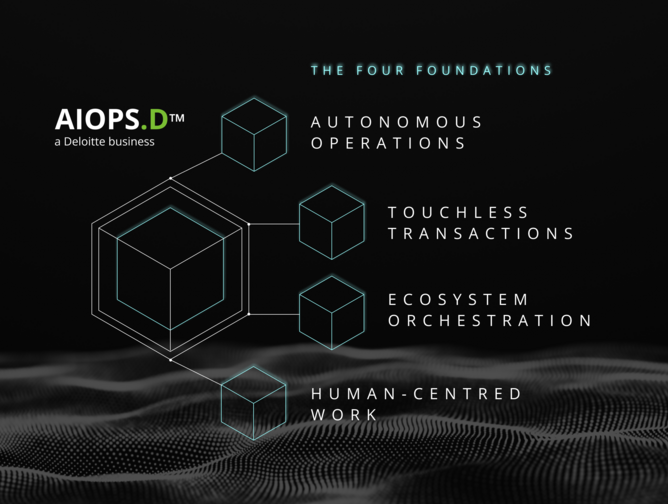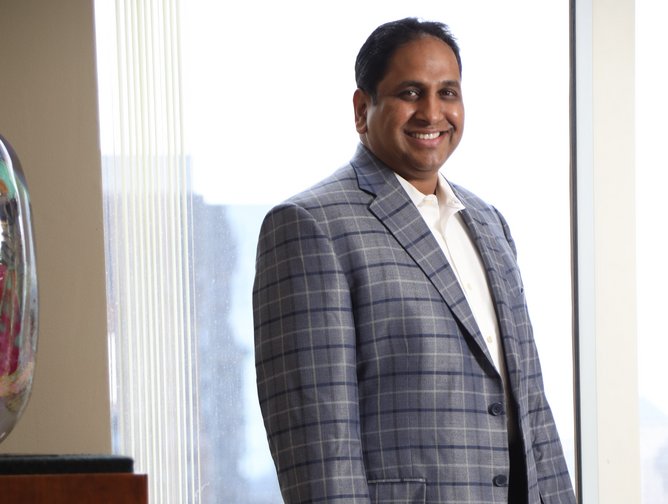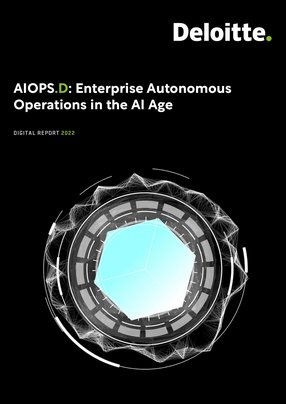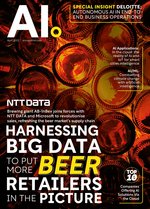Jag, can you tell us about AIOPS.D, and why enterprises are taking a fervent interest in the integration of AI and operations?
First – it’s certainly an exciting time for AI as we emerge from COVID. In the last few years, enterprises have seen the biggest disruptions in the way that they work – resilient enterprises are now elevating the importance of decision support whether it is conventional or remote work. Data management and optimal decisions, and responses, are becoming more complex, while asking the person next to you maynot be a workplace staple of the future.
Taking a holistic view of the enterprise – across enterprise application landscapes and business processes, and I say this with deep understanding and empathy of the nuances and complexities – organisations at large, historically, are only incrementally evolving, regardless of organisation vision or goals. Operations, and the workforce, are still laden with manual processes, manual tasks, and a heavy reliance on human integration to understand and solve for data gathering, understanding, and process completion. Automation rose in the last half-decade to tackle specific tasks and use cases, not the entire end-to-end process – the span for improvement to close the gap to human support remains wide.
For example, for some enterprises, digitization is limited to manually-managed email – many employee actions and requests are done through the inbox. How do you know what to tackle first? How do you know what is the correct optimisation of your immediate time and priorities?
These kinds of questions, which require true, actionable intelligence, are why we had to think through the detailed design that goes into creating the AIOPS.D autonomous process assets, in the form of unique yet integrated à la carte microservices. We’re fundamentally changing the way our clients conduct business - we want them to achieve true autonomous operations via microservices, which are essentially the ‘digital assistants’ that will run the enterprise.
Our vision around creating these autonomous process assets is built on four main foundations:
1. Autonomous Operations, with less human intervention in end-to-end business processes
2. Rules-based Touchless Transactions, where human decision-making is supported and focused on exceptions
3. Full Ecosystem Orchestration, with no ERP left behind
4. A focus on Human-Centred Work, by redesigning work and the workforce experience to focus on high-value, high-impact actions and decisions
What do you see as the mission of AIOPS.D? How can it help the enterprise?
At Deloitte Enterprise AI Operations, more specifically AIOPS.D, we believe in simplicity and improving workforce happiness by letting people do what people do best – make complex decisions – and letting machines do what machines do best – managing a growing stack of data – that, inevitably, is at or near the edge of human non-manageability.
Our mission is to deliver autonomous process assets to empower our clients to achieve highly intelligent and resilient business operations. It’s time to think about AI in terms of end-to-end business outcomes; the early successes of targeted solutions such as RPA have been great accelerators, but there is more that happens between RPA and a business outcome that still requires substantial human intervention.
This new era – it’s about bringing the work to the people, with digital workflows, and clear prompts for human intervention. We want to enable machine-learning from workforce interaction – not to reduce labour, but to improve accuracy, so that an employee can have strategic conversations, not debate the calculation method across different operating groups, or conduct calls with three separate departments to resolve a single data point.
We were struck by the evolving definition of AIOPS in the market. Can you explain how AIOPS.D is different?
Important question. I can’t say enough about the excitement here about the portfolio of capabilities we have completed, and our framework for the portfolio of microservices we have in development, all of which will speak to each other. It’s one, interconnected modular web of capabilities, just as operations should be.
To your question – the idea of AIOPS was originally defined in the context of how AI can help IT manage systems reporting – maintenance, updates, performance, and so on. When we thought about it, our approach is that with technology so much at the heart of operations today, just as how IT improves with better collaboration between systems and humans, so can operations.
With AIOPS.D, this is our take on how we manage operational data modernisation, our language for an API-first approach, frictionless development, and human-centred design. We want people to actually use the systems that are built, and derive meaning – via an ideally delightful experience – in being able to gain insights from actionable data that used to require massive effort to achieve. When we say human-centric, it’s not a byword, we mean it.
We want to take clients on that journey of addressing the black box of AI, and integrate employee enhancement deep into our initial planning – that is how we differentiate. Our commitment and our value to clients are interwoven – we plan for AIOPS.D to be subscription-based – once enterprises see the value, we believe they will continue to explore the portfolio. Our cards are on the table – their gains come first, and our solutions will continue to evolve to meet operational and market needs.
Going back to the fourth foundation, one of the biggest fears and interpretations is around how AI impacts the workforce – how do you see this evolving?
Let me answer your question with a historical reference point on automation. Yes, there was a tremendous shift in societal constructs, including the nature of work, as we evolved from farming to industrial. However, the rise of AI in the enterprise is more aligned with addressing specific, tactical problems in the routine, rising-volume, and human-error prone components of work today – we are improving productivity and accuracy.
Take, for example, the ‘automated banker’ fear from 30 years ago – we use this term all the time today – ATMs – and yet, the freeing of humans from counting-centred tasks has led to a net increase in bankers and an explosion in financial services offered.
AIOPS.D is about what machines and humans each do best. Employees’ knowledge of the firm can be applied to solve more enterprise and career-enhancing challenges than untangling data. A machine cannot devise a strategic plan for any action large or small – that requires cooperation with the workforce, one that has been properly trained to understand how AI solutions can plug into their daily, weekly, monthly, quarterly, annual – and so on – routines.
Think about what you and I do in any day – how much of our time is spent managing routine tasks. We all know this is a significant time sink and has only trended upward in recent years.
All of us – I guess – probably spend more than half of our time managing operational outcomes that are puzzling in terms of process efficiency.
Absolutely! That is what we are here to solve – invoicing, financial planning, human resource capability delivery. It’s 2022 – the need to do everything by hand, by document, is coming to an end, and the companies that do not capitalize, this will impact their workforce experience, recruiting and retention. Companies start by talking about their strategy and perks but a well-run, efficient organisation in core operations – that is a differentiator and class of its own.
We have read your website’s overviews of AIOPS.D – what do you mean by ‘beyond predictive?’
When we say this, we are referring to the different eras of data management, in terms of how users have interacted with data sets. Historically, data has just grown in volume – so, a workforce had no choice but to be reactive and non-integrated in their response – enterprises made critical business decisions based on the best available information. Not quite the era of going with your gut, but not really the era of real-time data-based decision-making, either.
Then, technology solutions promised proactive monitoring. This is a fantastic progression but what does the user do with the information once they receive it? The response could differ by employee, by department,
by what was going on with that person that day. We want to have system recommendations that are actionable, to generate more predictability in operational outcomes.
Humans can decide the parameters of decision-making - and technology can optimize those choices, operating within these rules. We are choosing to have a more manageable and engaging workday – that is what AIOPS.D can offer – the ability to have a human and machine workforce responding in a coordinated manner to real-time events, to drive decision-making support. Not only does this raise the IQ of your enterprise in real-time, it enhances the EQ responses from your employees by freeing them of the frustrations of the ‘process of’ vs. the outcomes they were trained and hired to achieve.
Let’s turn to the executive perspective. How should an enterprise leader be thinking about Operations for the coming decade?
Executives should be thinking of Autonomous Process Operations in the 4 foundations I referenced earlier – Autonomous Operations, Touchless Transactions, Ecosystem Orchestration, and Human-Centred Work.
I’ve discussed parts of that already, so I’ll say a few words on Ecosystem Orchestration – this is a way of saying that an end-to-end autonomous process must occur across platforms to solve for and answer workforce questions without platform gaps.
For CIO / CDO / CTOs and their teams – this is where we talk about self-healing architecture, APIs for interconnectivity, frictionless design, no ERP left behind and conversational AI. What we are saying here is the user experience matters, the technology infrastructure must be inclusive and also feature the capabilities we ascribe to AI – so that we do not deliver a wonderful front end with many people behind the scenes pulling the cords per se. We don’t want a simulated Wizard of Oz, we want real autonomy, built with an elevated human experience.
Are all operations areas open to autonomy? Are some more manual or inefficient today than others?
Well, we see the biggest opportunities in the Office of the Chief Data Officer, Procurement, Finance, Financial Planning, and recently we have seen the pervasive Supply Chain challenges. Without going too many levels in, we see this as much an issue about inflexible systems and a disconnect between machine outputs and human decision-making as it is about production gaps. One challenge may be the root cause, but operational disconnects are the root amplifier.
If you were to recap AIOPS.D’s impact in a few key phrases, what would that be?
I’d say that at the 30,000-foot level, it’s about moving data to a viable management strategy as we shift from linear process to an exponential, interconnected one.
On a more tactical level, I’d say that AIOPS.D is about:
- A self-driven Enterprise –AI-enabled monitoring of operations 24/7, and generating actionable insights
- Elevating the workforce with prompts for human decision-making and action – enabling the right action at the right time
- Delivering AI at scale – aligned to end-to-end business processes and operations
AI has had so many associations over the years – science fiction, targeted data engines, and a black box of workforce and societal implications. We want to unpack all of that with AIOPS.D and demonstrate that it's time to ‘plug in’ at scale, and that AI delivers, what we call, your Operations, Unchained.






